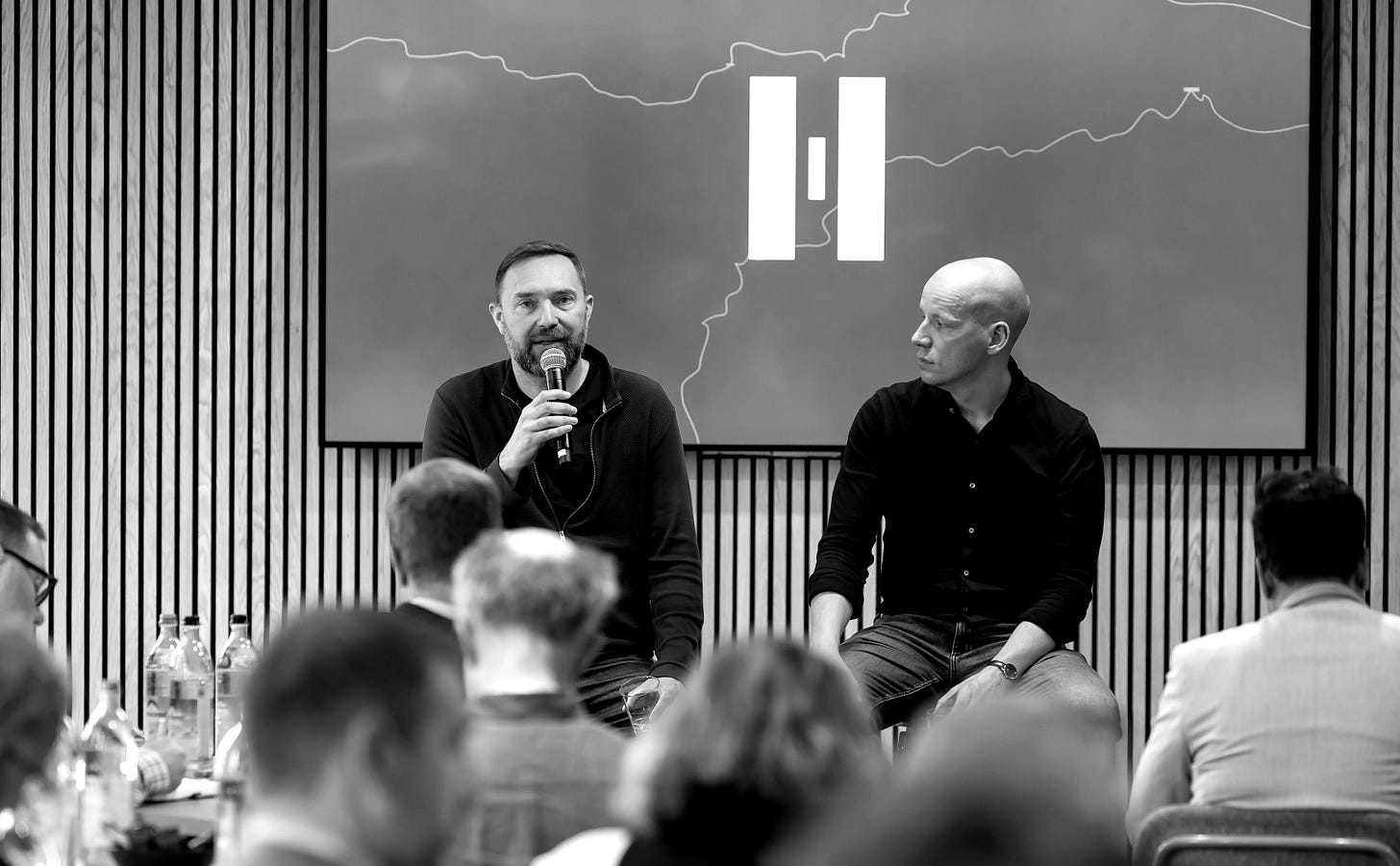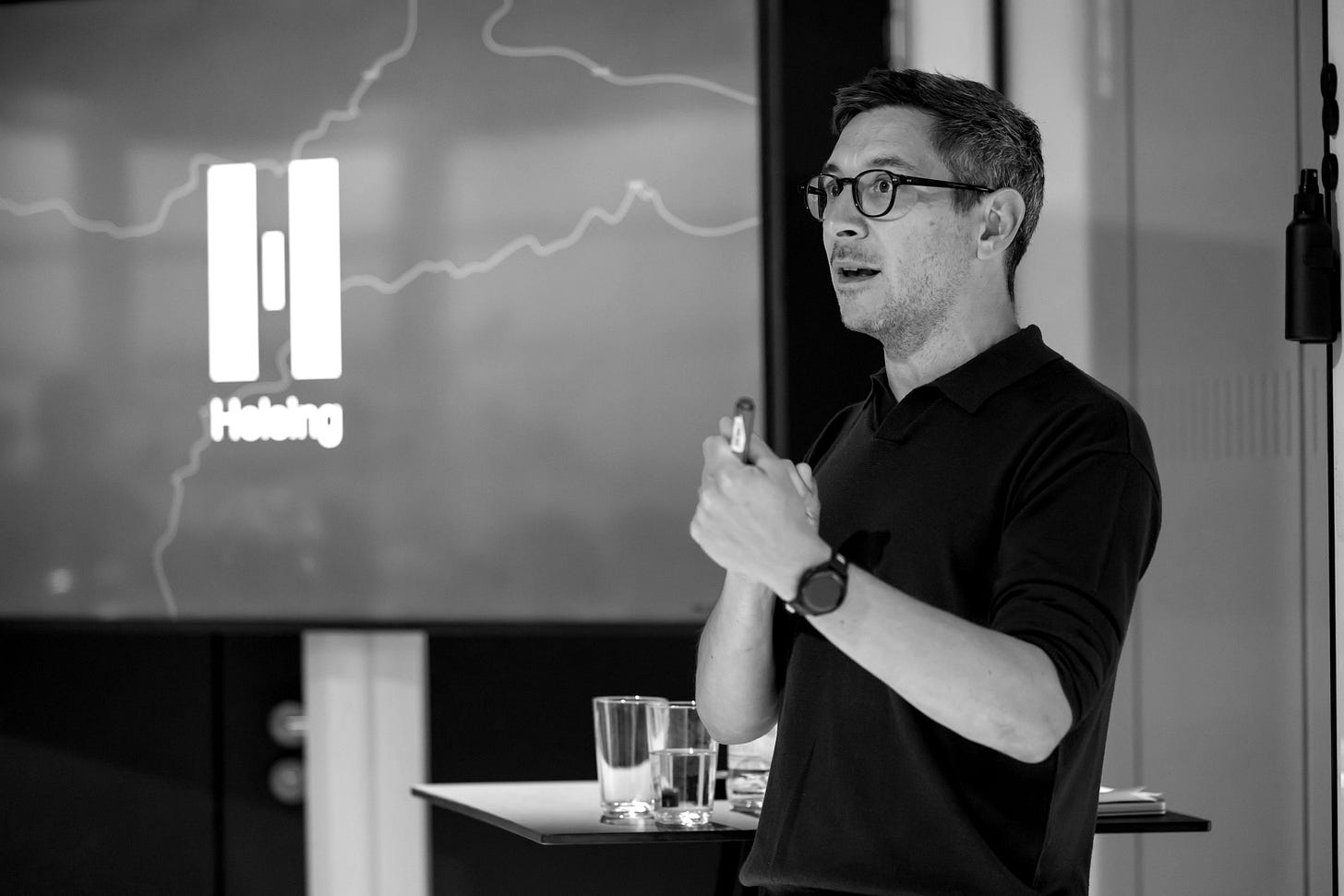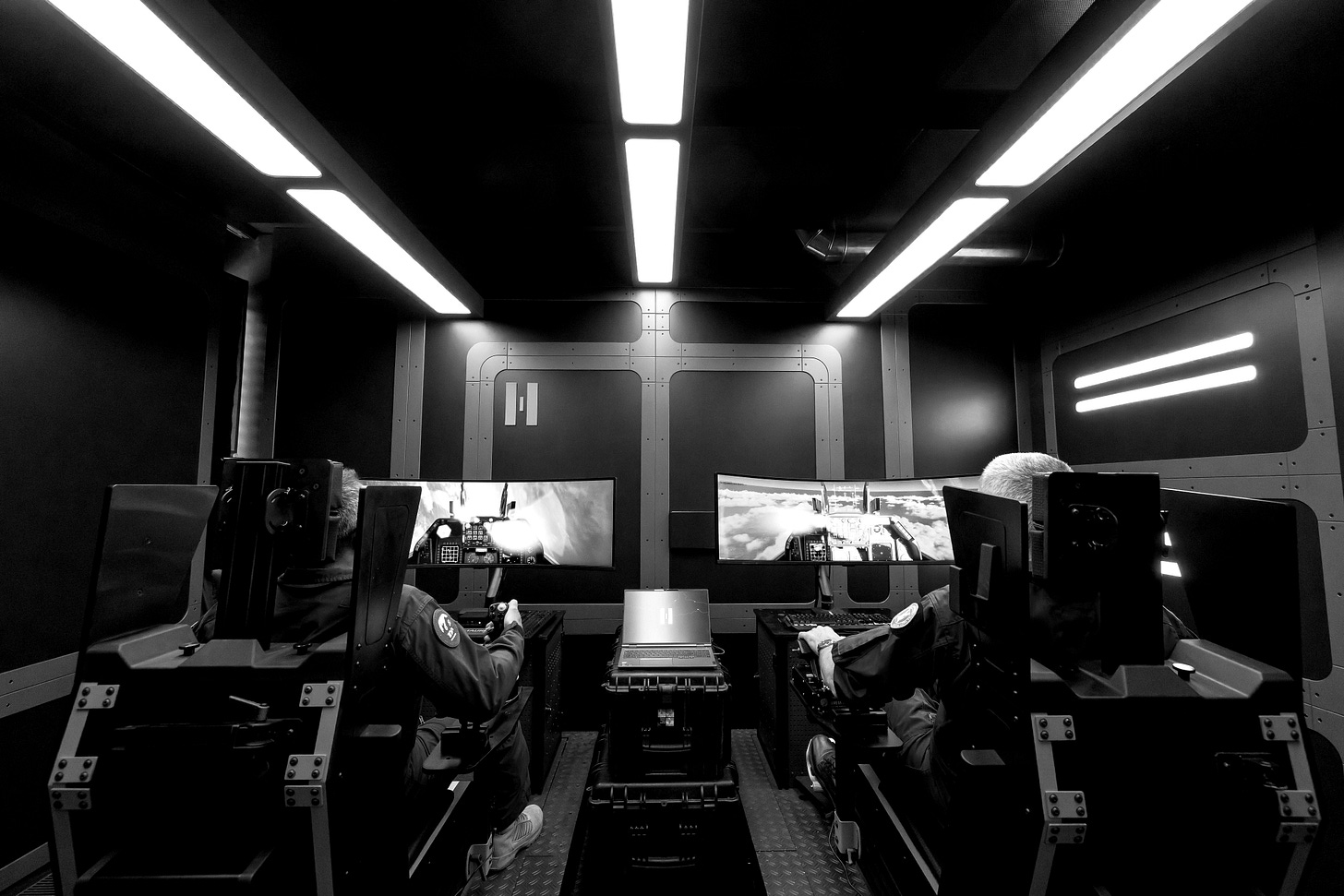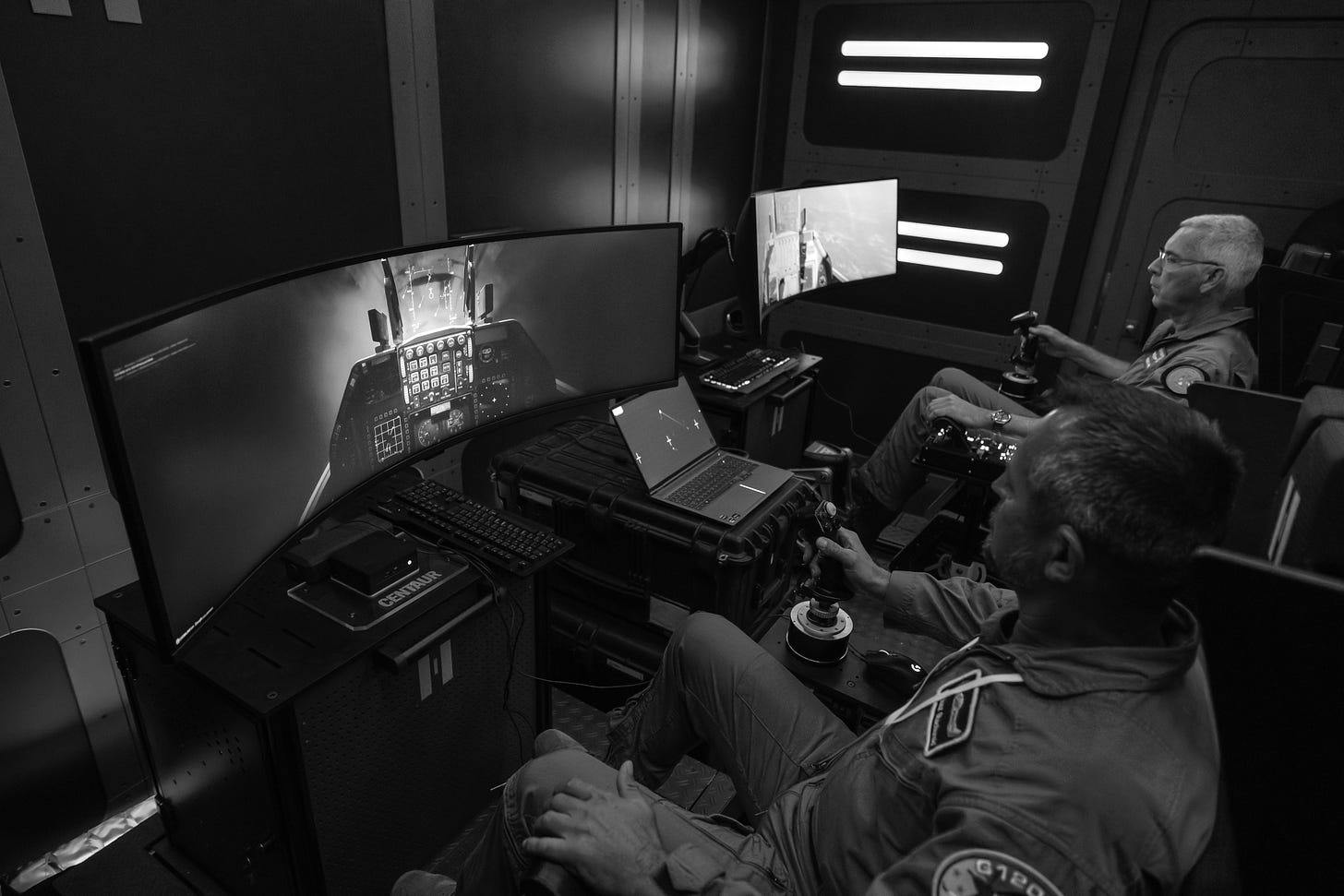The Long Read: How Helsing Sees the World
During its first press day, Helsing offered an inside view into its technologies, team, and perspective on the threat landscape
Helsing has rapidly become a big name in technology and defence circles in Europe: with nearly €1.4 billion in funding, reportedly at a €12 billion valuation, as of June 2025, the Berlin-based company has been securing a string of partnerships and building out infrastructure to produce air and underwater tech to secure Europe. Yet the company has largely remained under the radar when it comes to talking about their work.
On a sunny July day in Munich, Helsing held its first press day. Described in the mainstream press as ‘secretive’ this day proved they are willing to be anything but. A large group of journalists from around Europe convened in their office, leaving their phones and computers in a secure room and firing up newly-purchased dictaphones. The half-day briefing that followed offered deep insights into Helsing’s technologies, team, and views on the defence tech and threat landscape.
If one line framed the day, it was from Helsing co-founder and co-CEO Dr Gundbert Scherf: ‘Deterrence is only credible if you can move fast.’
Here's what we learned over 6 hours with the Helsing team.
‘Inverting the capability triangle’
In the traditional defence paradigm, co-founders and co-CEOs Scherf and Torsten Reil explained, most of the focus was, and remains, on the platform. Traditional defence has been focused on building ‘very complex platforms that have great capabilities.’ They are basically hardware with some software on top to support the platform.
With software-defined defence, and the use of autonomy, you can invert that capability triangle and have sensors and autonomy as the key driver of effect and speed, with the platform there to support the software. In this way, in the air Helsing wants to dominate electronic detection and fast response; on land they want to solve the fragmented kill chain; with maritime, detection is a huge problem. Scherf and Reil believe that AI can solve this complexity.
AI for Democracy: Growing a team of AI experts and what Europe gets wrong
Helsing is now 600 people strong, having doubled its headcount in the last year. After their recent investment round, they are now hiring the best people they can find. Sam Rogerson, Helsing’s Chief Operating Officer, explained the realities of hiring out of Silicon Valley’s tech giants. Those companies have the best talent available, which comes both with a price and with an interest in being more than ‘coders for hire.’ Rogerson explained that with AI, having years of experience behind you is not necessarily useful as the latest knowledge relies on understanding just the last 2-3 years of innovations.
Helsing’s third co-founder, Niklas Köhler, talked about the limiting factors faced by Europe in scaling AI. The money and compute power needed for AI research is currently only available in the private sector. The EU fails in AI because the public sector does not pick champions, and instead fragments funding and resources across Europe, partly because each country wants to have its own strategy and champions.
Consequently, companies like Helsing can succeed because they have raised enough private capital to focus a ‘huge resource’ on hiring the best talent. ‘No matter how smart your scientists are, no matter how ingenious your approach is, at the end how much resource you funnel into these topics makes a big difference,’ Köhler explained.
He went on to explain that in this current market, if you want to do state of the art AI research, you have to work in a lab which can afford to do that state of the art research. He explained that this is not possible in public academia anymore: ‘You only find this at Meta, at Google, at Tesla, at these type of companies... And it's a matter of having compute, so enough data centre access, [and] a big enough problem to solve that you actually can afford to funnel these types of resources into these things.’
The problem exists more broadly across the defence tech sector. Reil and Scherf’s concern is that by not concentrating critical mass we end up with a small company working on drone autonomy, another small startup looking at underwater sensing, another just working on sensing for larger aircraft. In their opinion, this will look competitive for a couple of years, and then all of it ‘gets annihilated usually by a US company who is able to focus 10, 100, or 1000 times the resource on the entire problem set,’ Köhler said.
Beyond the corporate aspect of this argument, Scherf talked at length about the need for sovereign capabilities to sense and respond to threats. Referring to a piece he had published recently, he emphasised that Europe needs to be sovereign when it comes to targeting, saying ‘Targeting is the absolute core domain in modern defence. You need to be able to detect your targets, know where they are… in almost real time from space. You've got to be able to link that to your land integrated kill chain.’
Domain Dominance: Land, Air, Maritime
In small groups, escorted by security, we were taken around the building and introduced to the lead for each of their domains – land, air, and maritime. The new offices are very smart. In the dedicated maritime domain room we found the SG-1 Fathom deep sea glider situated in the middle of the room against dark metallic wall panels and dim coloured lighting.
In the maritime domain, Scherf had explained that, ‘I think it's not acceptable that we are still not clear what's happening underwater. This is a domain that, of course, Russia has invested a lot into because they know we've de-invested from this in the last decades. And I think we've got to go into that to secure critical infrastructure.’
Amelia Gould, General Manager, Maritime, explained that there are more than 60 major undersea cables that provide 95% of our Internet and that we cannot protect all of this all of the time; it’s necessary to address the problem differently.
Showcasing Lura, their AI-enabled software platform for the underwater battle space, she explained how it uses large acoustic models trained on terabytes of underwater acoustic data. It has also been trained with naval sonar operators to understand the human processes. It will classify a noise, for example as a fishing boat, but can then go further and ask whether it has heard that particular sound signal before and can even name the ship. It works out where it is, where it is going, and how fast. In particular it can ‘see through the background noise’ of the ocean in a way a human would struggle to do, effectively amplifying the sound of quieter objects whilst cancelling out the background sounds.
Gould went on to explain that they now have enough conviction in the software to start scaling, manufacturing, and delivering Lura on the SG-1 Fathom glider sub to customers using the Helsing approaches that they learned from the HX-2, in particular keeping the supply chain as small as possible and the components as simple as possible. Gliders are the simplest form of underwater platform that can take you to sea, and the SG-1 Fathom, like the HX-2, is a relatively simple piece of hardware, already widely used in the commercial market. It is the software deployed on the platform that creates the advantage.
The air domain room was equally striking, with internal doors that slid apart to reveal two retired fighter pilots in fatigues sitting at flight simulators. We then watched on a large screen as two AI piloted fighter jets engaged them in a dogfight. When the AI jet hit the human piloted jet, the screen on one of the simulators showed the plane in a tailspin with flames and smoke in front of the pilot, a stark reminder of what is at stake here.
Before being ‘killed,’ one of the human pilots had fired a rocket at the AI plane, which turned at the very last second to avoid it. Helsing’s Head of Air Domain, Stephanie Lingemann, explained that only an AI system could calculate an evasive turn that last minute. A human pilot both could not make that calculation, and would also calculate in the risk to their life.
Lingemann went on to explain the striking fact that it takes 3-7 years to train a fighter pilot. Experienced pilots retire with around 5000 flight hours. An AI pilot can reach 1m flight hours training in 72 hours.
Deterrence through Mass
Helsing are now also focussed on mass production. They believe this is essential to create the deterrence of speed and mass against an army that outnumbers Europe and NATO in both men and machines. Their head of Land Domain, a former German soldier, showed the assembled journalists their core drone frame, which without the motors or electronics takes around 45 minutes to assemble. Inside the casing it is remarkably and impressively simple. This speaks to the point made by Scherf about inverting the capability triangle – this is a simple platform carrying sophisticated software.
The founders stressed the importance of asymmetric technologies: we have seen our adversaries use mass to attack, but we lack mass, both in terms of soldiers and hardware, so we have to focus on technology that has 10x or 100x more impact. Part of achieving this is speed and precision, and real time sensing is key. A large strike drone attack can be launched very quickly and is therefore a good deterrent. This compares to countering Russian tanks with allied tanks that may take days or even weeks to arrive.
The team have been briefed that when a full-scale war starts with Russia, the German Army alone will need 60 days supplies of ammunition in storage as it would use up to 2000 autonomous systems per day. The Army would need 120,000 drone systems in storage ready for the first 60 days of a war. They also anticipate that Russian intelligence would know about many of these stores and may destroy 40-50% of the supplies in the first hours of the war. So, they believe the army will need nearer 200,000 systems in stock just to buy enough time to ramp up production in those first 60 days to meet the needs of the German Army. For the whole of NATO, and all along the Eastern Flank, that number is far greater.
This is the reality of mass production and meaningful deterrent.
Diverse platforms but focussed tech
Considering all of this diversification, Reil and Scherf were challenged about a possible lack of focus. In response, the founder pointed out that while appearing to be fragmented, each domain has a significant overlap on the technology side.
Köhler went on to explain that, ‘the way you store data, the way you get data across a network, the way you actually have a command and compute control, so the way you control your asset if it's a small flying drone, a big flying drone, something that drives, something that swims. There's huge overlap in the technology foundation that you have to invest in to make these things robust…As an example, the inference engine which runs our AI models in the Eurofighter EW program is the same that we run on a small drone.’
They went on to explain that the same is true for the network aspect; how information is buffered, how constrained networks are dealt with, and narrow bandwidth environments are very similar across all of these domains.
Area 9
Antoine Bordes, Helsing’s Chief Scientist, introduced Area 9, their new internal incubator. This captured the attention of most of the publications in attendance, but few questions could be answered on the record.
What we do know:
Area 9 should have a team of 40-50 people by the end of the year.
As a project built on such rapid and blue sky innovation, Area 9 needs its own team, budget, and objectives that are separate from the rest of Helsing.
This new division is where much of the work with Mistral is happening, and in many ways sounded like it was inspired by the original Skunk Works.
On innovation, Dr Robert Fink, CTO explained that their approach is to aim BIG. This attracts the best people, and to aim big you need the best teams. But also retain focus, so if you aim big you must also focus.
Building a sovereign European company
Helsing has set out from its origins to build an all-domain European company that uses AI combined with mass production to meet threats to democracy. Throughout the day, Reil and Scherf stressed the importance of being a fully European company with European talent. This talent is being repatriated largely from big tech companies in the US, to help fulfil their mission to create sovereign defence capabilities in Europe. Reil explained that they created an EU sovereign company by raising their seed round from European investors and then making sure they had more EU investors in further rounds. Consequently, the company is still 80% owned by EU investors.
The need for R&D spend
The team explained their view that the previous prime model for defence saw companies wait until government had defined a requirement, and then contracted one company to build that requirement. This has led to a lack of speed, and to companies spending around 3% on R&D.
The new model that Helsing is part of sees venture funded companies spend nearer 30%-40% on R&D without waiting for the contracts. This moves risk away from government to the company and its investors, and should deliver better innovation faster, which is what the speed of modern warfare requires.
In relation to building AI companies, Reil explained that ‘it costs a couple of billion now to build the right teams and build the right setup up here [in Europe] to be able to compete. If you sit this out and wait five to seven years and then talk about what we need to catch up on military grade AI autonomous systems, you will be so far off you simply cannot catch up anymore.’ Reil added:
‘we can’t wait for government to give us R&D contracts. The geopolitics won’t wait…Putin refurbishes or makes I think about 1500 tanks every year. We know that he puts the large majority into storage, and I think we have to assume that he intends to use them somehow, and probably not in Ukraine.’
Autonomy: The Human in the kill chain
There was a heated discussion about the role of humans in the kill chain. The Head of Land Domain, Simon Brunjes, explained that their drones require a human to sign off an attack. This means they have to extend the space between target and decision, and if the drone loses contact it is programmed to abort the attack and return to the last point it had contact with the command post. Then the decision to attack or not must be made again by a human.
This is partly to protect civilians in the battlefields of Ukraine. Responding to a question, he explained that it is technically possible to remove the human from the kill chain, but from their moral perspective they have decided not to support machine to machine decisions, or full autonomy.
Brunjes explained how he has personally seen targets near the front line that are also close to Ukrainian kindergartens and civilian traffic: ‘In such an environment you want to have a human being making the decision and not the machine.’
He continued that in another scenario, for example a full-scale war with Russia or China, then it would be a different question. If the other side does not care about these moral perspectives, we risk losing a war if we cannot match their capabilities. We cannot lose a war because of these ethical questions, but we should be aware of them.
No plans to IPO
Reil was asked directly about rumours they would IPO the company. He responded, ‘we're not planning an IPO right now, it's not something that we ever talk about quite frankly.’ However, he explained it is an important direction for the company because they want it to stay independent. Reil told the group, ‘we are not looking to ever sell this company to someone else. It needs to stay an independent company. It can do that privately, but it can also do that on public markets. But it can't happen through a trade sale.’






